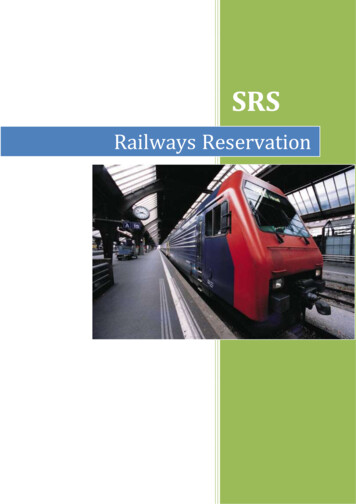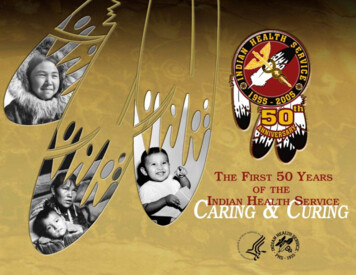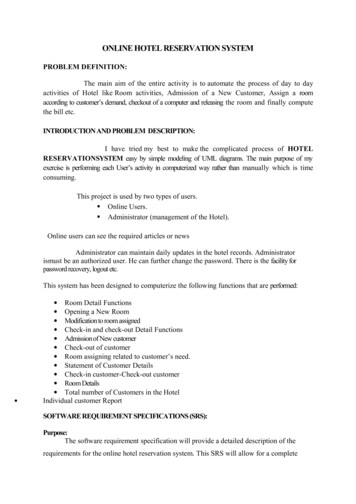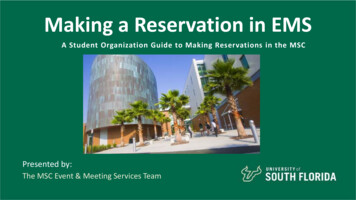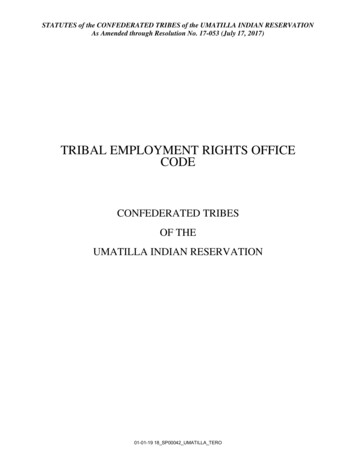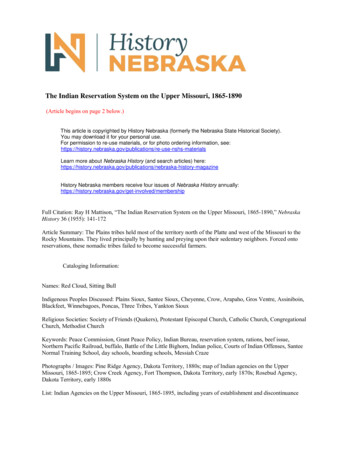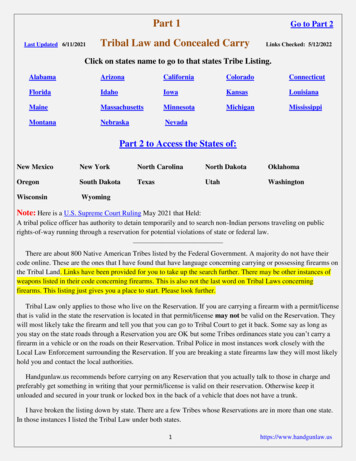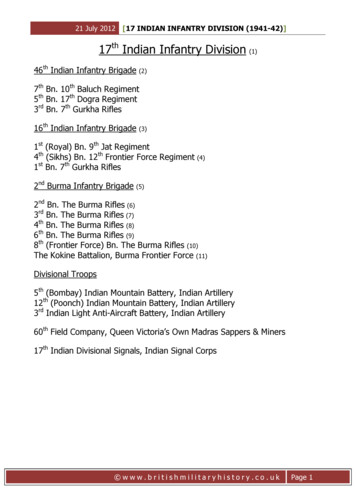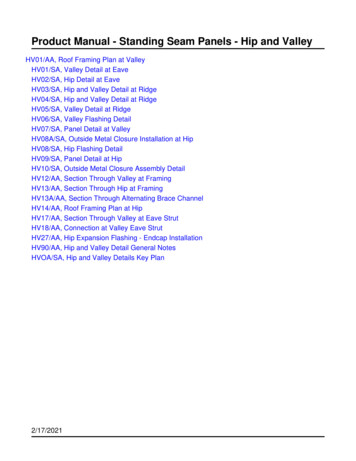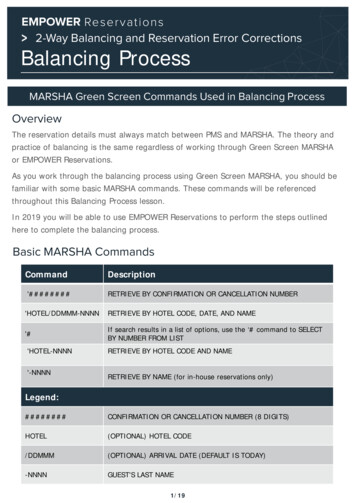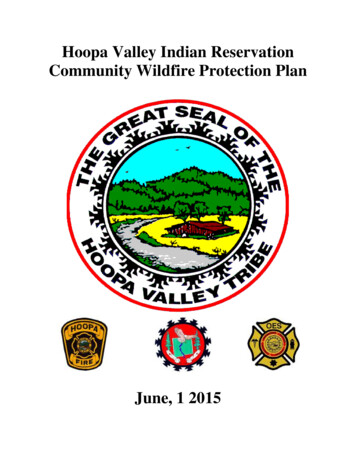
Transcription
Hoopa Valley Indian ReservationCommunity Wildfire Protection PlanJune, 1 2015
Table of ContentsContents1.2.Introduction . 11.1.Purpose and Need . 11.2.Planning Team and Process. 1Community Description . 32.1.Community Description . 32.2.Fuels Mitigation . 52.3.Fire History . 72.4 Wildland Urban Interface . 834.Policies and Programs . 103.1Healthy Forests Restoration Act (HFRA) . 113.2National Fire Plan. 113.3Federal Land Assistance, Management and Enhancement . 113.4National Fire Protection Association (NFPA) Codes and Standards . 123.5Federal Emergency Management Agency (FEMA) Disaster Mitigation Act . 13Wildfire Risk Assessment . 134.1Wildfire Hazard . 144.1.1Slope and Weather Patterns . 154.1.2Heavy Fuel Loading. 184.1.3Limited Access and Egress . 224.1.4High Residential Density . 244.1.5High Structural Vulnerability . 254.2Protection capabilities . 274.35Values at Risk . 27Mitigation Action Plan. 315.1High Priority Actions . 31Himalayan blackberry, Himalayaberry . 31Removal . 33Recommendation . 345.2Other Actions . 345.2.1Fuels Mitigation Projects . 34i Page
5.2.2Increased Responsibility and Funding . 355.2.3Long Term Wildfire Risk Reduction Planning with WUI Partners . 355.3Education and Community Outreach . 365.4Monitoring and Evaluation. 36References . 37ii P a g e
List of FiguresFigure 1: showing location of Hoopa Valley Indian Reservation, major roads, topography anddefined urban area. . 3Figure 2: Map showing the 7 Hoopa Valley Indian Reservation Districts as well as critical (red)and noncritical (blue) infrastructure. 5Figure 3: Pictures showing before and after fuels reduction work on a Tribal Community FuelsReduction Project to make a recreation area usable again. . 7Figure 4: Map showing 1999-2003 wildfires displayed by cause and size for the Hoopa ValleyIndian Reservation (From USGS Federal Wildland Fire Occurrence Data (2014)). . 8Figure 5: Map showing the Community Wildfire Protection Plan Wildland Urban Interface(WUI), the 7 Hoopa Valley Indian Reservation Districts as well as critical (red) andnoncritical (blue) infrastructure. . 10Figure 6: Map showing the 2008 Fire Hazard Severity Map for Hoopa Valley Tribe IndianReservation . 15Figure 7: Map showing slope as a percent rise for the Hoopa Valley Indian Reservation and aclose-up of the buffered (1.5 miles) area of urbanization as a defined Wildland urbaninterface (Developed from NED 10 DEM). . 16Figure 8: Showing Northern Interior California Palmer Drought Severity Index andClassifications for 1895-2014. Values below -1.0 on the graph are considered to be indrought conditions. Please note that 2014 was most extreme drought conditions since1895 (From NOAA (2015)) . 17Figure 9: Map showing vegetation classes for the Hoopa Valley Indian Reservation includingenlargement of district area. . 18Figure 10: Pictures A) and B) shows the woody understructure of the Himalayan Blackberry, itsability to become a major ladder fuel and how it aggressively replaces native grassesand shrubs. . 20Figure 11: Picture showing vegetation including Himalayan Blackberry encroachment on watertank. 20Figure 12: Map showing potential locations of Himalayan Blackberry infestation and vegetationtype change in the Trinity River Valley Hoopa Indian Reservation near districts.Maps developed from data supplied by Hoopa Forestry (2015). 21Figure 13: Map showing main (Highway 96) and secondary evacuation routes for Hoopa ValleyIndian Reservation. . 23Figure 14: Examples of residential fire risk in high density communities on the Hoopa ValleyIndian Reservation. A) Firewood stacked next to house and B) Firewood stackednext to propane tank . 24Figure 15 Shows examples of the vegetation/debris as well as multiple structures in thedefensible space zones. . 26Figure 16: False color image (Vegetation is red and bare ground blue) showing potentialblackberry location A and B in Campbell district. . 32Figure 17: Examples of overgrown Himalayan Blackberry thickets in the Campbell District,Hoopa Indian reservation. . 32iii P a g e
List of TablesTable 1: CWPP Process and key Hoopa Valley Indian Reservation members . 2Table 2: 2013 Hoopa Forestry Fuels Reduction Accomplishments . 6Table 3: 2011 Potential Wildfire Loss estimates . 28Table 4: 2011 Critical infrastructure by district and majority Fire Risk Level . 30List of Maps (Full Plates in Appendix A)Map 1: Location Map of Hoopa Valley Indian Reservation with area of urbanizationMap 2: Hoopa Valley Indian Reservation Districts as well as critical and noncriticalinfrastructureMap 3: 1999-2003 wildfires displayed by cause and size for the Hoopa Valley IndianReservationMap 4: Community Wildfire Protection Plan Wildland Urban Interface (WUI), Hoopa ValleyIndian Reservation Districts, and critical and noncritical infrastructureMap 5: 2008 Fire Hazard Severity Map for Hoopa Valley Tribe Indian ReservationMap 6: Slope as a percent rise for the Hoopa Valley Indian Reservation and close-up of theWildland Urban Interface (WUI)Map 7: Vegetation classes for the Hoopa Valley Indian Reservation including enlargement ofWUIMap 8: Potential locations of Himalayan Blackberry infestation and vegetation type change inthe Trinity River Valley Hoopa Indian Reservation near districtsMap 9: Main (Highway 96) and secondary evacuation routes for Hoopa Valley IndianReservationList of AppendicesAppendix A: MapsAppendix B: Completed Community Wildfire Risk and Hazard Assessment Forms NFPA 2991144 and Blank form for future useAppendix C: Education and Community Outreach Documentationiv P a g e
2015 Hoopa Valley Indian Reservation Community Wildfire Protection Plan1.Introduction1.1.Purpose and NeedThe Hoopa Valley Indian Reservation (HVIR) is a region of steep terrain, large areas ofcontinuous fire fuels, long periods of drought, and a region of high arson activity makewildfire a major concern for the Tribe. Action can and should be taken to help reduce theoverall risk of wildfire while developing a community that is resilient to the aftereffect of amajor fire. These steps can also help improve the ecosystem around HVIR by restoringnative plants (used for ceremony and economy), and improve response to wildfire. Toachieve this a combination of assessment, education, mitigation (fuels and housing safety)and effective fire suppression must be undertaken to achieve the goal of a resilientcommunity and its surrounding wildlands to be prepared for the effects of wildfires.To achieve the goal of a fire safe community the United States Congress passed the 2003Healthy Forests Act (HFRA), which allowed for the development of Community WildfireProtection Plans (CWPP). The CWPP educates and creates a pathway for communities tounderstand and reduce their wildfire risk. The CWPP achieves this through an understandingof fire risk to the community as well as the area defined as the interface between thecommunity and the wildlands (Wildland Urban Interface – WUI).1.2.Planning Team and ProcessThis CWPP is written for the Hoopa Valley Indian Reservation to develop assessment,outreach and mitigation planning actions for wildfire risk reduction. This is not a legaldocument but is meant to educate and help secure potential funding for the Tribe. The workdone for this CWPP followed the timeline as listed below in table 1. The work was completedwith input from the HVIR community, subject matter experts both internal and external to theHVIR and reviewed by the HVIR CWPP key members also listed in table 1. The list of keyCWPP members in not inclusive of everyone who helped in the process of the CWPPdevelopment.1 Page
2015 Hoopa Valley Indian Reservation Community Wildfire Protection PlanTable 1: CWPP Process and key Hoopa Valley Indian Reservation members*TaskExplanationForm decision teamDevelopment of responsible parties at Hoopa ValleyIndian ReservationInvolve Federal PartnersEngage Bureau of Indian Affairs, U.S Forest Service,Humboldt County and CAL FIRE and other agencies asappropriateMeet with subject matterexpertsCommunity meeting with decision team and communitysubject matter experts to determine and prioritize location,issues, concerns, and mitigation plansMeet with CommunityCommunity meeting with decision team and communityto determine and prioritize location, issues, concerns, andmitigation plansEstablish base mapDevelop a base map that defines community at riskincluding wildland urban interface and criticalinfrastructureDevelop Fire RiskAssessmentLook at topography, climate, fuels, access, residentialdensity and structure risk to categorize overallcommunities fire riskForm mitigation actionplan based on SME andcommunity inputDevelop a mitigation plan based on risk assessment andcommunity meeting based on prioritization fromdevelopment team, subject matter experts and communityFinalize CWPPReview with development team and finalize CWPPHoopa Valley IndianReservation Approval ofCWPPReceive approval from Hoopa Valley Indian ReservationTribal Council on CWPPHoopa Valley Indian Reservation CWPP Key Members*Darin Jarnaghan Sr.Forestry Manager, Hoopa Tribal ForestryKevin LaneFuels Specialist, Hoopa Tribal ForestryRod MendesDirector Office of Emergency Services, Hoopa ValleyTribeAmos PoleFire Chief, Hoopa Volunteer Fire Department HoopaValley TribePliny (Jack) JacksonChairman, Hoopa Fire Safe Council, Hoopa Valley TribeJim CampbellGIS Specialist, Hoopa Forestry*Please note that since the completion of the CWPP in June of 2015 that the Hoopa ValleyWildfire department has been restructured and is now the Hoopa Valley Fire Department(HVFD) and the main point of contact is Rod Mendes, Chief Hoopa Fire Department and2 Page
2015 Hoopa Valley Indian Reservation Community Wildfire Protection PlanDirector of the Office of Emergency Services. The HVFD reports directly to the TribalChairman. This note documents the change in communication structure and point of contactfor the Hoopa Valley Fire Department and the Hoopa Valley Indian Tribe CommunityWildlfire Protection Plan.2.Community Description2.1.Community DescriptionThe Hoopa Valley Indian Reservation (HVIR) is located in the Northeastern portion ofHumboldt County, California. It is located 65 east miles of Eureka, 120 Miles west ofRedding and 300 miles north of San Francisco. The HVIR is roughly square in shape withsides approximately 12 miles long encompassing an area of over ninety two thousand acrescovering approximately 50% of the Hupa Aboriginal territory. Figure 1 shows location ofHVIR in relation to Eureka, San Francisco and Sacramento in Northern California.Figure 1: showing location of Hoopa Valley Indian Reservation, major roads,topography and defined urban area.3 Page
2015 Hoopa Valley Indian Reservation Community Wildfire Protection PlanThis makes HVIR the largest reservation in California. The main area of urbanizationincluding Tribal government is located in the Trinity River Valley Floor. The valley islocated near the reservation center and approximately 6 miles long by a mile wide. TheValley is separated into 7 districts, or fields, which represent traditional villages of the HoopaPeople. The field names are Norton, Soctish/Chenone, Mesket, Agency, Bald Hills,Hostler/Matilton and Campbell. These districts constitute the classified urban area in theCommunity Wildfire Protection Plan (CWPP) with a 1.5 mile buffer. The slope increasesdramatically and is steep sloped and heavily forested above the valley floor.According to the 2010 US census the total population of HIVR is 3,041. The majority of thispopulation live (85%) live in the 6 districts that are situated on the valley floor. The largestconcentration of housing is in Campbell district. The Bald Hill district contains the rest ofthe HIVR population as dispersed housing in an upland setting. Commercial buildings arescattered along Highway 96 but are mainly concentrated in Agency, Campbell andHostler/Matilton. Medical services including Kimaw Medical & Dental clinic, ambulanceservice and the rest home are located in Hostler/Matilton. Tribal government, records andmost offices, as well as the K-12 schools and head start program, are located in Agency.These all were identified as critical infrastructure by the HIVR. Figure 2 shows the districtslocation on the HIVR as well as defined critical infrastructure (Tribal, commercial, andfederal) in red and noncritical infrastructure in blue.4 Page
2015 Hoopa Valley Indian Reservation Community Wildfire Protection PlanFigure 2: Map showing the 7 Hoopa Valley Indian Reservation Districts as well ascritical (red) and noncritical (blue) infrastructure.2.2.Fuels MitigationFuel mitigation for the Hoopa Valley Indian Reservation is managed by Hoopa Forestry(Hoopa Wildland Fire Department (HWFD)). Despite a lack of funding from the BIA andother sources, the HWFD has developed a fuel mitigation strategy that includes: fuelsreduction, timber sales, Wildland Urban Interface (WUI) management, and maintains or5 Page
2015 Hoopa Valley Indian Reservation Community Wildfire Protection Planimproves cultural resources (traditional plants as an example). They have also worked todevelop a fire prevention strategy that emphasizes the importance of enforcement in deterringincendiary fires.Fuels reduction in all areas consists of prescribed burns, fuel breaks, hazel and Beargrassimprovements, wildlife enhancement and specific work done on WUI lands. In 2013 a totalof 782 acres received mechanical treatment while another 733 acres were prescribed burned.Table 1 below shows a summary of 2013 fuels reduction by Hoopa Forestry.Table 2: 2013 Hoopa Forestry Fuels Reduction AccomplishmentsProject TypeTimber SalesBeargrass HabitatEnhancementHazel Habitat EnhancementFuel BreaksWildlife enhancementWUI Specific fuelsreductionTotals AcresMechanicalTreatment(acres)300RX Burn(acres)30015156675266605230026782733Additional work planned for 2014 is to 150 acres of prescribed cultural burning (Beargrassand Hazel habitat enhancement), 100-500 acres of fuels reduction burning, and 300-500 acresof timber sales burning. An example of the type of work was the Tribal Community FuelsProject. This project was initiated to take a popular recreation area and return it to a useablestate by removing hazardous fuels and noxious plants (poison oak). Figure 3 illustrates theeffect a planned fuels reduction project can have for access and usability of an area with ahigh fuel load.6 Page
2015 Hoopa Valley Indian Reservation Community Wildfire Protection PlanFigure 3: Pictures showing before and after fuels reduction work on a Tribal CommunityFuels Reduction Project to make a recreation area usable again.2.3.Fire HistoryWildfires are a part of life in the western United States and especially northern California.CAL FIRE has documented the entirety of Hoopa Valley Indian Reservation (HVIR) is on a35 year burn cycle or less, and of mixed intensity. Between 1999 and 2013 there were a totalof 1,963 reported wildfires on the HVIR with over 97% being less than 10 acres in size (BIAdata from USGS Federal Wildland Fire Occurrence Data (2014) website). The majority ofthese fires (98.5%) were human induced while all of the naturally occurring fires werecaused by lightning strikes. The table below lists a selected group of wildfires includingnames, year, and acreage covered that were in the HVIR boundaries: Megram Lightning Fire, October 1999: 4,830 Reservation acres (125,000 acres total) Hoopa Fire, July 1999: 54 acres Big Hill Fire, September-October 2002: 184 acres Supply Creek #13 Fire, August- September 2002: 410 acres Deerhorn Fire, September 2008:382 acres Mill Creek 4 Fire, October-November 2009: 1,942 Reservation acres (2,750 acres total) Mill Creek #1 Fire, July 2010: 50 acres Campbell Field #4, September 2012: 58 acresThe costs associated with wildfire and other fire incidents between the years 1999-2011 onthe Reservation are totaled at 15,710,150. Figure 4 shows the total number of wildfires7 Page
2015 Hoopa Valley Indian Reservation Community Wildfire Protection Planfrom 1999-2013 reported by the Bureau of Indian Affairs to USGS Federal Wildland FireOccurrence Data (2014) website.Figure 4: Map showing 1999-2003 wildfires displayed by cause and size for the HoopaValley Indian Reservation (From USGS Federal Wildland Fire OccurrenceData (2014)).The Native people of Hoopa Valley understood and used the natural cycle ofburning. Cultural burning for clearing areas for crops, basketry material (Hazeland Beargrass, and hunting has been done for thousands of years in the region.According to tribal elders, traditional and naturally occurring fires were used to“cleanse” the land and were allowed to burn naturally without suppression.This resulted in fuel load reduction and decreases in fire severity and intensity.2.4 Wildland Urban InterfaceThe determination of the Wildland Urban Interface (WUI) for the development of the CWPPwas based on the community demographics, critical infrastructure and political boundaries.The definition of a WUI is ‘where houses mingle or meet with undeveloped wildland8 Page
2015 Hoopa Valley Indian Reservation Community Wildfire Protection Planvegetation.’ The California Fire Alliance in 2001 defined the buffer region for a WUI to be1.5 miles from the edge of defined structures. This value represents approximately thedistance a firebrand can be carried from a wildfire to the roof of a structure. This bufferreinforces the idea that structures not near a potential wildfire location can still be at risk. Itshould be noted that due to ceremonial locations, wildlife and food harvesting across thereservation, the entire reservation is classified as a WUI. However, this classification wasreduced for this study to concentrate on the developed areas and the nearby regions only.Since nearly all structures (both critical and noncritical) on HVIR are within the 7 definedpolitical districts (Figure 2), it was determined that these districts will serve as the base of theWUI. We determined that the 1.5 mile buffer around the districts would potentially capturethe direct interface area as well as any new building that has occurred since the structure mapwas developed by Hoopa Forestry. Figure 5 shows the defined WUI (districts and 1.5 milebuffer) for this study along with critical and noncritical infrastructure.9 Page
2015 Hoopa Valley Indian Reservation Community Wildfire Protection PlanFigure 5: Map showing the Community Wildfire Protection Plan Wildland UrbanInterface (WUI), the 7 Hoopa Valley Indian Reservation Districts as wellas critical (red) and noncritical (blue) infrastructure.3Policies and ProgramsThe Hoopa Valley Indian Reservation CWPP is designed to be a planning document that is usedin conjunction with other HVIR fire management and fuels reduction plans/legal documents tocreate a fire safe environment for the Hoopa community.There are no legally bindingrequirements to implement any of the recommendations in the HVIR CWPP. Any actions onTribal land will be subject to, and require compliance with, Tribal policies and procedures aswell as any applicable federal, state, and county policies and procedures. Any actions taken onprivate land should be in accordance with applicable land use codes, building codes and tribal10 P a g e
2015 Hoopa Valley Indian Reservation Community Wildfire Protection Plangovernance. The HVIR CWPP must also be approved by the Hoopa Tribal government, HoopaForestry, and Hoopa Volunteer Fire Department.There are several federal legislative acts that outline policy and guidance for the development ofthe HVIR CWPP.3.1 Healthy Forests Restoration Act (HFRA)The HFRA enacted in 2003 is federal legislation to promote healthy forest and open spacemanagement, hazardous fuels reduction on federal land, community wildfire protectionplanning, and biomass energy production. The HFRA promotes gathering of information onwildland fire, early detection of pest/disease outbreaks allowing for ecosystem 2 National Fire PlanIn 2000 Congress mandated the implementation of the National Fire Plan. This plan is a longterm commitment to deal with issues on unsustainable wildland fuel and ecosystemconditions that have evolved from up to 100 years of active fire suppression in the UnitedStates. In conjunction with the Western Governors association a 10-year comprehensivestrategy (2001) which developed an interagency plan that focuses on firefightingcoordination, firefighter safety, post-fire rehabilitation, hazardous fuels reduction,community assistance, and accountability.This plan directed federal agencies to workdirectly with communities to develop adequate fire protection as well as maintain thecondition of the land. More information on the National Fire Plan can be found here:http://www.fireplan.gov, and for the 10-year comprehensive strategy implementation planhere: /.3.3 Federal Land Assistance, Management and EnhancementIn 2009 congress passed the Federal Land Assistance, Management, and Enhancement Act of2009 (the FLAME Act).This legislation was a natural continuation of the previouslegislation and actions taken by the Partner Caucus on Fire Suppression Funding Solutions11 P a g e
2015 Hoopa Valley Indian Reservation Community Wildfire Protection cy-work-forests-fire/); a coalition of over 160 environmental, industry, outdoorrecreation, and forestry organizations led by National Association of State Foresters (NASF),The Wilderness Society and American Forests. They led the initiative to develop legislationthat will lead to sustainable fire suppression strategies in the United States by the Departmentof the Interior and the U.S. Forest Service. There are components in this legislation thatallow for community risk assessment, methods for allocation of hazardous fuel reductionfunding based on priority projects, and reinvest in non-fire programs, all of which progresstowards creating fire resilient communities. The 2009 FLAME Act: Report to egy/documents/reports/2 ReportToCongress03172011.pdf) has detailed information for further review.3.4 National Fire Protection Association (NFPA) Codes and StandardsThe NFPA is an international not-for-profit agency designed to reduce the loss of life andproperty by developing codes, standards, training, and educational outreach protocols. Theyhave developed more than 350 standards and have over 65,000 members worldwide. Thesestandards/codes cover everything from a standard for electrical safety in the workplace(NFPA 54) to Life Safety Code (NFPA 101). There are five standards that are used widelyfor wildland fire suppression and intensity reduction for communities. They are: NFPA 1141: The Standard for Fire Protection Infrastructure for Land Developmentin Suburban and Rural Areas covers the requirements for the fire protectioninfrastructure in suburban and rural areas when Land use/ land change occurs. This isimportant for rezoning but also new development. NFPA 1142: The Standard on Water Supplies for Suburban and Rural Fire Fightingidentifies a method for determining the minimum requirements for alternative watersupplies for structural fire-fighting purposes in areas. This standard is only applicablewhere the jurisdictional authority determines that adequate and reliable water supplysystems do not otherwise exist. NFPA 1143: The Standard for Wildland Fire Management provides minimumrequirements for fire protection organizations on the management of wildland fire,including prevention, mitigation, preparation, and suppression. This standard isalready met by Hoopa Forestry. NFPA 1144: Standard for Reducing Structure Ignition Hazards from Wildland Fire.This standard provides a methodology to assess wildland fire ignition hazards around12 P a g e
2015 Hoopa Valley Indian Reservation Community Wildfire Protection Planexisting structures and residential developments as well as planned or improvedproperties that will located in the WUI. It also provides minimum requirements fornew construction in the WUI. The main goal of this standard is to reduce the numberof structures ignited from wildland fires. NFPA 299: Standard for the Protection of Life and Property from Wildfire. Thisstandard provides a method for the assessment of wildfire hazard Severity Analysisexisting and improved structures; location, design and construction of new structures;creation of defensible space and community planning. This is one of the fundamentalstandards for community wildfire protection.These five standards, as well as a review of all other codes/standards, if appropriate, shouldbe considered for future planning by Hoopa Valley Indian Reservation. More informationincluding all detailed information on the codes and standards can be found at the NFPAwebsite: ons-and-plans.aspx.3.5 Federal Emergency Management Agency (FEMA) Disaster Mitigation ActThe FEMA Disaster Mitigation
Map 3: 1999-2003 wildfires displayed by cause and size for the Hoopa Valley Indian Reservation . Map 4: Community Wildfire Protection Plan Wildland Urban Interface (WUI), Hoopa Valley Indian Reservation Districts, and critical and noncritical infrastructure . Map 5: 2008 Fire Hazard Severity Map for Hoopa Valley Tribe Indian Reservation
